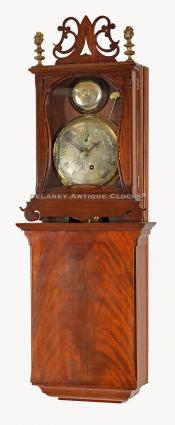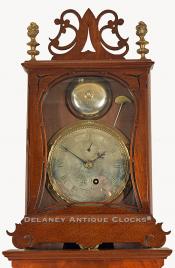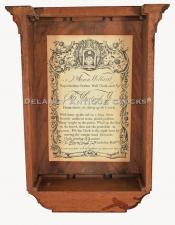Ted E. Burleigh Jr's reproduction of Aaron Willard's Primitive Wall Timepiece. This is an excellent copy of the original form. This is number 40 of 47. BBB-17.
This wall clock represents a rare form as fewer than three dozen original examples are currently known to have been made by Simon Willard (1753-1848) and his younger brother Aaron Willard (1757- 1844). The original clocks represent Simon's inventive genius and illustrate his trend toward developing smaller clock movements. The American Revolution brought on shortages of brass and price increases of everyday goods. Due to their scale, these clocks were more economical to produce. Though still costly at the time, the price of these prototype clocks was approximately one-fifth the price of a tall case clock. Willard advertised them on his labels as "Timepieces which run 30 hours and warranted price 10 dollars." Loosely resembling a portable, spring-powered clock resting on a bracket, this thirty-hour timepiece is weight-powered, strikes once each hour, and displays the time on a silvered engraved brass dial. The movements are housed within highly figured mahogany cases. These were crowned with elaborate pierced fretwork and brass finials. This form eventually evolved into his very successful Patent Timepiece.
Ted Burleigh lived and worked in Winchester, Massachusetts. He and his wife, Fran, owned and operated the Gilders Workshop, which opened in 1972. Before 1975, the business focused on doing restoration and gilding work. It was after 1975 that clock production began. Ted was the frontman of this side of the business. He chose the forms to reproduce and ordered the various components that came in from a number of sources. Ted did some carving and finished most of the cases. He assembled and completed the clocks. He was also the point of sale contact. His reproductions were very high quality. The first clocks that he copied were wall timepieces or banjo clocks. There were four versions. The cross-banded versions were modeled after Simon Willard's patent clocks. The gilded versions were closely patterned after those made by Lemuel Curtis in Concord, MA, before 1820. The opportunity to copy an original Lemuel Curtis Girandole presented itself in 1973.
Ted copied the example now on loan at the Museum of Fine Arts in Boston. This clock is very well known to clock collectors and is often pictured as a representation of the form. It features a wedding scene in the lower glass. In 1980, the Burleighs were able to copy an Aaron Willard Grafton Wall Clock. This clock is now in the collection at Sturbridge Village. The Burleighs modified their version by redesigning the movement of their clock to run 8 days instead of the original format of 30 hours. The case design is faithful to the original. They made 47 of these clocks, and were originally priced at $2,700. Clock production ceased about 1989 as Ted's health deteriorated.
The fine example offered here measures approximately 25.5 inches long. The case is constructed in mahogany and is finished in shellac. The backboard forms the structure of the case. The side edges of this board are carved with an ogee shape. The case form can be divided into two sections. The lower section slides forward and away from the case. Behind it is space for the lead drive weight to fall and an area for the brass pendulum bob to swing. The T. E. Burleigh Jr paper label is on the back of the panel. This clearly states that this clock is a "Reproduction." It also provides the clock's setup information. Most importantly, it is numbered "40" and is signed by Ted Burleigh in ink. The front features a highly figured crotch mahogany panel. The side edges are canted. A cornice molding is fitted to the top of the base. Some say this creates the illusion that the upper section of the case sits on this molding. The upper section doubles as a door. It is hinged on the right. At the bottom is a bracket-style base molding that features scrolled-out feet and a drop apron. The shape of the feet slightly resembles the form later used in the design of the lower section of Simon Willard's brass timepiece sidearms. This molding is applied to a small cove molding. The main area of the door features a large kidney-shaped opening. This is fitted with glass. The opening is designed with a separate wooden trim piece that frames the interior edge. This is spaced from the mainframe of the door by carved diamonds. In the upper corners of the door are additional pierced designs. The side edges of the door are also canted. Fitted above the cornice molding at the top of the hood are two cast brass finials and a pierced and open-style fretwork.
The cast brass bezel is decorated with rope turnings and beading. The brass dial is mounted to this bezel with screws. The dial is decoratively engraved and treated with a silver wash. The engravings include Arabic-style five-minute markers, a closed minute ring, Roman-style hour numerals, floral patterns, and a seconds register. It also is signed "A. Willard" in script across the center. The blued beetle and poker-style minute and hour hands are hand filed from steel. They are hand-filed and of outstanding quality. The brass washers mounted on the center arbor and the washer that holds the bell in place are also decorated with carvings. The bell is positioned above the dial.
The movement is constructed in brass and is die-stamped by the maker "KILBOURNE & PROCTOR INC., / 4137" on the front plate. The design of this movement has been altered from the original. This version is more user-friendly. The original movement versions were essentially one-day clocks. The Burleigh versions run 8 days fully wound. It is powered by a lead weight that falls directly below the movement inside the lower box section of the case. The steel pendulum rod supports a brass bob. The pendulum is rigidly affixed to the pallets. Like the original version, it does not have a suspension spring. You will notice a hammer and a bell above the works. These are for the fall-off strike mechanism striking only once each hour. It does not have a complete strike train.
This mahogany case measures approximately 25.5 inches long, 8.75 inches wide, and 3.75 inches deep. It was made circa 1985.
The original Willard versions of this clock form seldom appear in the marketplace. As a result, reproduction examples are eagerly sought after by collectors. The Burleigh versions might be the best of the group because they all have 8-day duration movements and the cases are accurate to the original form.
Inventory number BBB-17.
Gilders Workshop. Ted and Fran Burleigh, Winchester, Massachusetts.
The Gilders Workshop was located in Winchester, Massachusetts, and opened in 1972. The husband and wife team of Ted and Fran Burleigh were the principals. That year they produced 12 banjo clocks. Before 1975 they were primarily doing restoration and gilding work. Clock production didn't take off until Elmer Stennes died in 1975. The Burleighs did gilding work for Stennes in the end. Their work was excellent.
Ted was the frontman. He was also involved with the carving of various decorative elements and the preparation of the cases for gold leaf where expected. He did the finishing the mahogany cases. He was also responsible for the assembly of the clocks. Components came in from various sources and he assembled and completed the clocks.
Ted's wife, Fran, did the gilding of the decorative wooden components. She trained under Boston's master gilder, Nils Johnson. She learned both water and oil gilding, traditional techniques that made the Burleigh clocks so beautiful. Fran may have been best known for her skill in reverse glass painting and restoration. She was an exceptional artist and a very talented instructor. Fran trained at least three other artists to do reverse painting on glass. All three became very proficient in this skill. Their daughter Cindy worked with them until she married. Ann Banister was working there almost the entire time. Linda Abrams started in 1975 and worked there for approximately four years. After that time, she struck out on her own and continues to do very high-quality work. She is sought out by the most discerning of clientele.
The Burleigh clock dials were painted by Martha Smallwood. This is often helpful in dating an example because she had a habit of pasting a sticker on the back of her dials that dated when they were completed.
The cases were made by Chuck England. He started making cases for them in 1973 and continued to do so until the last run of banjo clocks was made in 1989.
The movements were supplied by Kilbourne & Proctor.
The first clocks were timepieces or banjo clocks. There were four versions. The gilded versions were closely patterned after those made by Lemuel Curtis in Concord, MA before 1820. It is not currently known to me how many banjo clocks they made. In 1981, they were priced at $1,100.
The opportunity to copy a Lemuel Curtis Girandole presented itself in 1973. Ted copied the example now on loan at the Museum of Fine Arts in Boston. That clock is very well known and is often pictured. It features a wedding scene in the lower glass. It appears that they made 50 of these. In 1981, they were selling for $3,000. This was their most expensive model. You could also order this clock with a thermometer in the waist glass as a special order.
In 1980, the Burleighs copied the Aaron Willard Grafton Wall Clock that is in the collection of Sturbridge Village. They modified the movement of their clock to run for 8 days instead of the original format of 30 hours. The case design is faithful to the original. They made 50 of these clocks which they priced at $2,700.




















